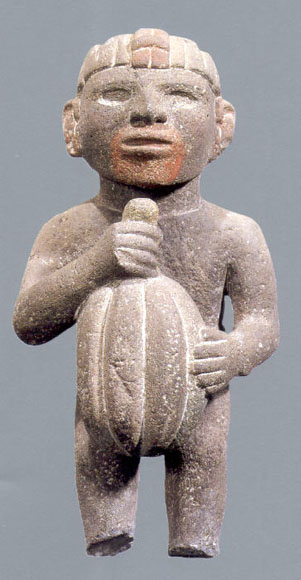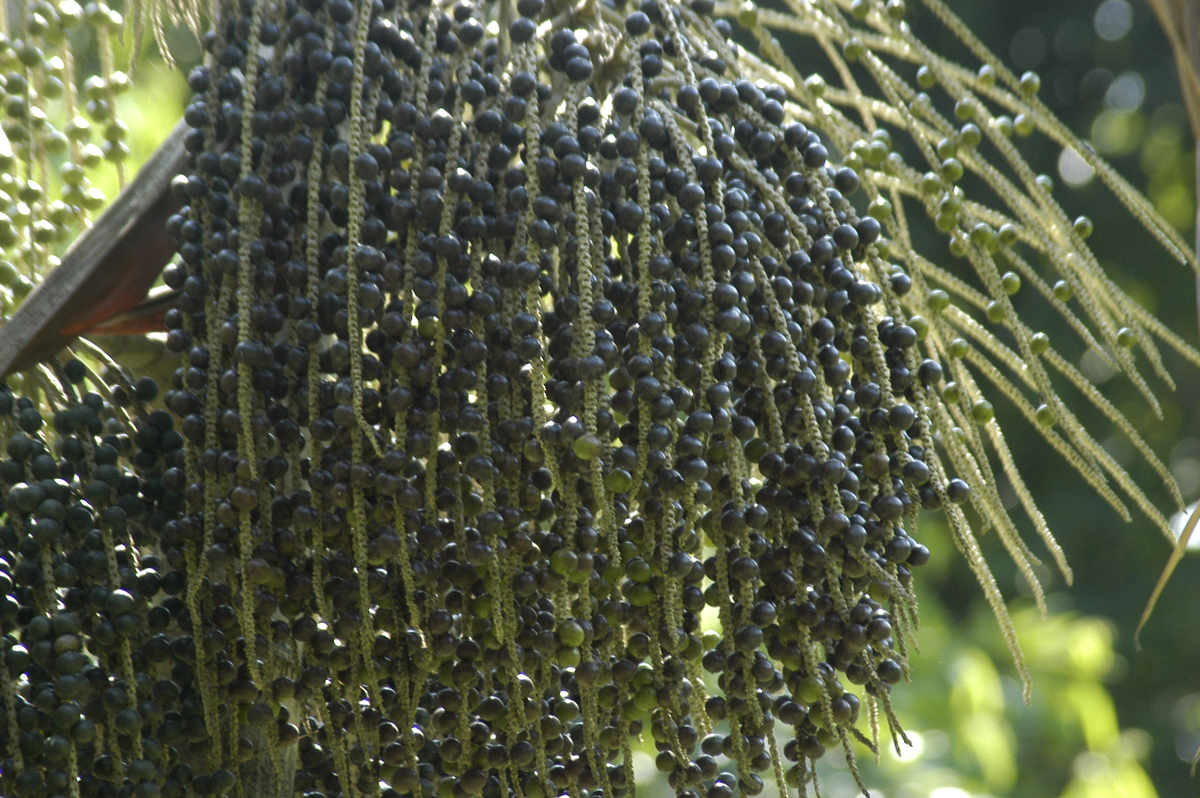|
Procyanidin
Procyanidins are members of the proanthocyanidin (or condensed tannins) class of flavonoids. They are oligomeric compounds, formed from catechin and epicatechin molecules. They yield cyanidin when depolymerized under oxidative conditions. See the box below entitled "Types of procyanidins" for links to articles on the various types. Distribution in plants Procyanidins, including the lesser bioactive / bioavailable polymers (4 or more catechines), represent a group of condensed flavan-3-ols that can be found in many plants, most notably apples, maritime pine bark, cinnamon, aronia fruit, cocoa beans, grape seed, grape skin, and red wines of ''Vitis vinifera'' (the common grape). However, bilberry, cranberry, black currant, green tea, black tea, and other plants also contain these flavonoids.USDA, August 2004USDA Database for the Proanthocyanidin Content of Selected Foods PDF summary accessed from main USDA pag Page accessed July 31, 2015 Procyanidins can also be isolated from ... [...More Info...] [...Related Items...] OR: [Wikipedia] [Google] [Baidu] |
Proanthocyanidin
Proanthocyanidins are a class of polyphenols found in many plants, such as cranberry, blueberry, and grape seeds. Chemically, they are oligomeric flavonoids. Many are oligomers of catechin and epicatechin and their gallic acid esters. More complex polyphenols, having the same polymeric building block, form the group of Condensed tannin, condensed tannins. Proanthocyanidins were discovered in 1947 by Jacques Masquelier, who developed and patented techniques for the extraction of oligomeric proanthocyanidins from pine bark and grape seeds. Proanthocyanidins are under preliminary research for the potential to reduce the risk of urinary tract infections (UTIs) by consuming cranberries, grape seeds or red wine. Distribution in plants Proanthocyanidins, including the lesser bioactive and bioavailable polymers (four or more catechins), represent a group of condensed flavan-3-ols, such as procyanidins, prodelphinidins and propelargonidins. They can be found in many plants, most notably ... [...More Info...] [...Related Items...] OR: [Wikipedia] [Google] [Baidu] |
Condensed Tannin
Condensed tannins (proanthocyanidins, polyflavonoid tannins, catechol-type tannins, pyrocatecollic type tannins, non-hydrolyzable tannins or flavolans) are polymers formed by the condensation of flavans. They do not contain sugar residues. They are called proanthocyanidins as they yield anthocyanidins when depolymerized under oxidative conditions. Different types of condensed tannins exist, such as the procyanidins, propelargonidins, prodelphinidins, profisetinidins, proteracacinidins, proguibourtinidins or prorobinetidins. All of the above are formed from flavan-3-ols, but flavan-3,4-diols, called ( leucoanthocyanidin) also form condensed tannin oligomers, e.g. leuco-fisetinidin form profisetinidin, and flavan-4-ols form condensed tannins, e.g. 3',4',5,7-flavan-4-ol form proluteolinidin (luteoforolor). One particular type of condensed tannin, found in grape, are procyanidins, which are polymers of 2 to 50 (or more) catechin units joined by carbon-carbon bonds. These ar ... [...More Info...] [...Related Items...] OR: [Wikipedia] [Google] [Baidu] |
Cocoa Bean
The cocoa bean, also known as cocoa () or cacao (), is the dried and fully fermented seed of ''Theobroma cacao'', the cacao tree, from which cocoa solids (a mixture of nonfat substances) and cocoa butter (the fat) can be extracted. Cacao trees are native to the Amazon rainforest. They are the basis of chocolate and Mesoamerican foods including tejate, an indigenous Mexican drink. The cacao tree was first domesticated at least 5,300 years ago by the Mayo-Chinchipe culture in South America before it was introduced in Mesoamerica. Cacao was consumed by pre-Hispanic cultures in spiritual ceremonies, and its beans were a common currency in Mesoamerica. The cacao tree grows in a limited geographical zone; today, West Africa produces nearly 81% of the world's crop. The three main varieties of cocoa plants are Forastero, Criollo, and Trinitario, with Forastero being the most widely used. In 2024, global cocoa bean production reached 5.8 million tonnes, with Ivory Coast leading a ... [...More Info...] [...Related Items...] OR: [Wikipedia] [Google] [Baidu] |
Açaí Palm
The açaí palm (, , from Nheengatu ''asai''), '' Euterpe oleracea'', is a species of palm tree (Arecaceae) cultivated for its fruit (açaí berries, or simply açaí), hearts of palm (a vegetable), leaves, and trunk wood. Global demand for the fruit has expanded rapidly in the 21st century, and the tree is cultivated for that purpose primarily. The species is native to eastern Amazonia, especially in Brazil, mainly in swamps and floodplains. Açaí palms are tall, slender trees growing to more than tall, with pinnate leaves up to long. The fruit is small, round, and black-purple in color. The fruit became a staple food in floodplain areas around the 18th century, but its consumption in urban areas and promotion as a health food only began in the mid-1990s along with the popularization of other Amazonian fruits outside the region. Name The folk etymology says that chief Itaqui ordered all newborns put to death owing to a period of famine. When his own daughter gave birth ... [...More Info...] [...Related Items...] OR: [Wikipedia] [Google] [Baidu] |
Açaí Oil
Açaí oil is obtained from the fruit of ''Euterpe oleracea'' (açaí palm), which grows in the Amazon rainforest. The oil is rich in phenolic compounds similar in profile to the pulp itself, such as vanillic acid, syringic acid, p-hydroxybenzoic acid, protocatechuic acid and ferulic acid as well as (+)-catechin and numerous procyanidin oligomers. Açai oil is green in color and has a bland aroma. It is high in oleic and palmitic fatty acids (table). Uses Açai oil is widely used for cooking and as a salad dressing. In cosmetics, it is used in shampoos, soaps and skin moisturizers. Source: See also *Açaí palm The açaí palm (, , from Nheengatu ''asai''), '' Euterpe oleracea'', is a species of palm tree (Arecaceae) cultivated for its fruit (açaí berries, or simply açaí), hearts of palm (a vegetable), leaves, and trunk wood. Global demand for th ... References Vegetable oils Cooking oils Açaí Crops originating from Brazil {{vegetable-oil-stu ... [...More Info...] [...Related Items...] OR: [Wikipedia] [Google] [Baidu] |
Green Tea
Green tea is a type of tea made from the leaves and buds of the '' Camellia sinensis'' that have not undergone the withering and oxidation process that creates oolong teas and black teas. Green tea originated in China in the late 1st millennium BC, and since then its production and manufacture has spread to other countries in East Asia. Several varieties of green tea exist, which differ substantially based on the variety of ''C. sinensis'' used, growing conditions, horticultural methods, production processing, and time of harvest. While it may slightly lower blood pressure and improve alertness, current scientific evidence does not support most health benefit claims, and excessive intake of green tea extracts can cause liver damage and other side effects. History Tea consumption has its legendary origins in China during the reign of mythological Emperor Shennong. A book written by Lu Yu in 618–907 AD, '' The Classic of Tea'' ( zh, t= 茶 經, s=, p=chájīng), ... [...More Info...] [...Related Items...] OR: [Wikipedia] [Google] [Baidu] |
Black Tea
Black tea (also literally translated as red tea from various East Asian languages) is a type of tea that is more tea processing, oxidized than oolong, yellow tea, yellow, white tea, white, and green tea, green teas. Black tea is generally stronger in flavour than other teas. All five types are made from leaves of the shrub (or small tree) ''Camellia sinensis,'' though ''Camellia taliensis'' is also rarely used. Two principal varieties of the species are used – the small-leaved Chinese variety plant (''C. sinensis'' var. ''sinensis''), used for most other types of teas, and the large-leaved Assamese plant (''C. sinensis'' var. ''assamica''), which was traditionally mainly used for black tea, although in recent years some green and white teas have been produced. First originating in China, the beverage's name there is ''hong cha'' (, "red tea") due to the colour of the oxidized leaves when processed appropriately. Today, the drink is widespread throughout East Asi ... [...More Info...] [...Related Items...] OR: [Wikipedia] [Google] [Baidu] |
Quercus Petraea
''Quercus petraea'', commonly known as the sessile oak, Welsh oak, Cornish oak, Irish oak or durmast oak, is a species of oak tree native to most of Europe and into Anatolia and Iran. The sessile oak is the national tree of Ireland, and an unofficial emblem in Wales and Cornwall. Description The sessile oak is a large deciduous tree up to tall, in the white oak section of the genus (''Quercus'' sect. ''Quercus'') and similar to the pedunculate oak (''Q. robur''), with which it overlaps extensively in range. The leaves are long and broad, evenly lobed with five to six lobes on each side and a petiole. The male flowers are grouped into catkins, produced in the spring. The fruit is an acorn long and broad, which matures in about six months. File:Divljanski stari hrast.jpg, Old sacred oak ( zapis) in Divljana, Serbia File:Quercus petraea 02.jpg, Shoot with leaves and acorn File:Eglinton fish pond island inosculated Q. petraea.JPG, An inosculated tree File:Sessile O ... [...More Info...] [...Related Items...] OR: [Wikipedia] [Google] [Baidu] |
Quercus Robur
''Quercus robur'', the pedunculate oak, is a species of flowering plant in the beech and oak family, Fagaceae. It is a large tree, native plant, native to most of Europe and western Asia, and is widely cultivated in other temperate regions. It grows on soils of near neutral Soil pH, acidity in the lowlands and is notable for its value to natural ecosystems, supporting a very wide diversity of herbivorous insects and other pests, predators and pathogens. Description Pedunculate oak is a deciduous tree up to tall, with a single stout trunk that can be as much as in girth (circumference at breast height) or even 14 m in Pollarding, pollarded specimens. Older trees tend to be pollarded, with boles (the main trunk) about 3 m long. They often live longer and become more stout than unpollarded trees. The crown is spreading and unevenly domed, and trees often have massive lower branches. The bark is greyish-brown and closely grooved, with vertical plates. There are often large burrs ... [...More Info...] [...Related Items...] OR: [Wikipedia] [Google] [Baidu] |
Oak (wine)
Oak is used in winemaking to vary the color, flavor, tannins (wine), tannin profile and texture of wine. It can be introduced in the form of a barrel during the fermentation (wine), fermentation or aging barrel, aging periods, or as free-floating chips or stave (wood), staves added to wine fermented in a vessel like stainless steel. Oak barrels can impart other qualities to wine through evaporation and low level exposure to oxygen.J. Robinson ''Jancis Robinson's Wine Course'' Third Edition pg 91-93 Abbeville Press 2003 History In early History of wine, wine history, the amphora was the vessel of choice for the storage (wine), storage and transportation of wine. Due to the perishable nature of wood material it is difficult to trace the usage of barrels in history. The Greek historian Herodotus noted that ancient Mesopotamians used barrels made of palm wood to transport wine along the Euphrates. Palm is a difficult material to bend and fashion into barrels, however, and wine merch ... [...More Info...] [...Related Items...] OR: [Wikipedia] [Google] [Baidu] |
Cranberry
Cranberries are a group of evergreen dwarf shrubs or trailing vines in the subgenus ''Oxycoccus'' of the genus ''Vaccinium''. Cranberries are low, creeping shrubs or vines up to long and in height; they have slender stems that are not thickly woody and have small evergreen leaves. The flowers are dark pink. The fruit is a berry (botany), berry that is larger than the leaves of the plant; it is initially light green, turning red when ripe. It is edible, but has an acidic taste. In Britain, ''cranberry'' may refer to the native species ''Vaccinium oxycoccos'', while in North America, ''cranberry'' may refer to ''Vaccinium macrocarpon''. ''Vaccinium oxycoccos'' is cultivated in central and northern Europe, while ''V. macrocarpon'' is cultivated throughout the northern United States, Canada and Chile. In some methods of classification, ''Oxycoccus'' is regarded as a genus in its own right. Cranberries can be found in acidic bogs throughout the cooler regions of the North ... [...More Info...] [...Related Items...] OR: [Wikipedia] [Google] [Baidu] |






